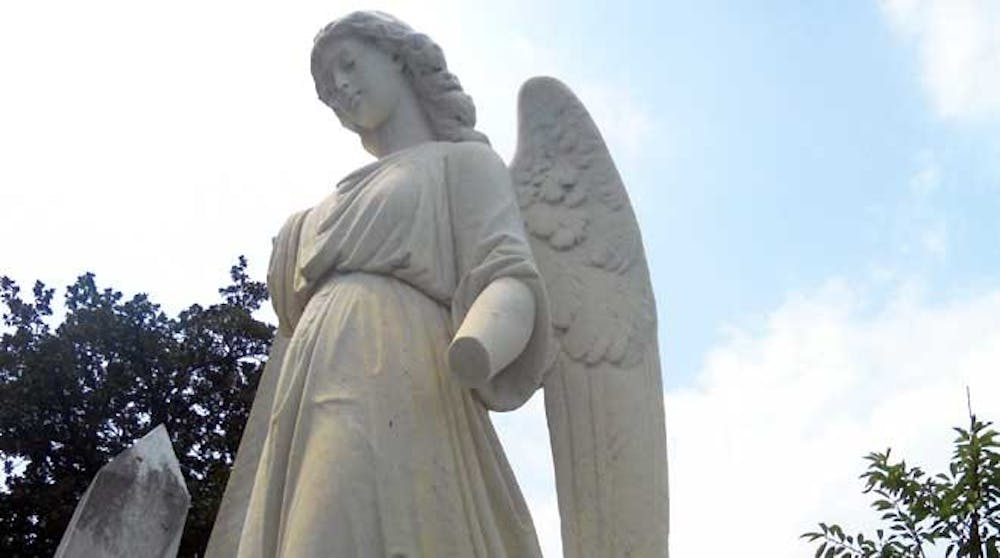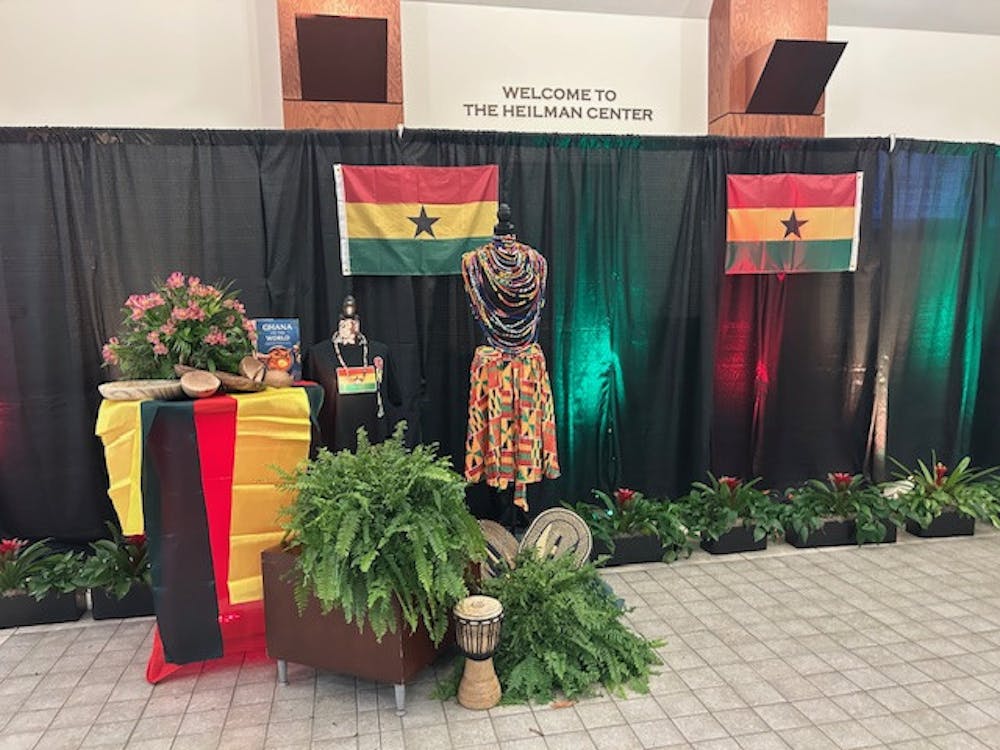As I pulled off the busy highway and around the corner into a quiet neighborhood, I kept my eyes peeled for the entrance of the Hollywood Cemetery. After a few seconds, I found what I was looking for and entered into the serene atmosphere.
I hopped out of my car and walked down the smooth blacktop toward the only three people in sight: two women giggling over a brochure and a tall man snapping pictures of an old iron gate. What was once the beautiful entrance to the cemetery is now hidden in the corner of the parking lot behind overgrown plants. In the rusted curve of the iron gate I glimpsed the cemetery's past, but this vision was quickly shattered by the modern-day townhouses lined up on its other side.
As I walked up to the women, our tour guide appeared suddenly and introduced himself. Walter Ikenrems was a short, bald man, who muttered off tons of facts about the cemetery, but only half were audible because he kept talking into his notebook. As he shifted his position and started walking down the hill, we all understood that the tour had begun.
Ikenrems said the holly trees scattered about were the reason why the place was named the Hollywood Cemetery. He started listing the other types of trees that were on the grounds, but his voice was lost over the hum of a large blue crane lifting up the remnants of a broken tree. Hurricane Irene caused many of the cemetery's skyscraper- trees to fall, so Hollywood was in the process of being cleaned. The modern-day machinery that screeched as it engulfed the wood looked so out-of-place among the quiet, ancient hills.
I walked onto the grass and ran my fingers over one of the tombstones. Its surface felt cool, even on an 80-degree day. I retracted my hand. It was eerie, but I had to laugh: the headstone had literally given me chills.
At that point, Ikenrems stopped in front of a cream pyramid that stood 90-feet tall and towered over the 18,000 Confederate soldiers buried in Hollywood Cemetery. He explained that it was dedicated to the Confederate soldiers of the "Lost Cause" and made up of rough-hewn Richmond granite - so unique and expensive that it had cost $26,000 in 1869.
The pyramid is so high that no crane could even reach the top of it to put the capstone in place. With no one willing to climb the pyramid, a sailor who was serving time in a nearby state penitentiary who had watched the construction of the pyramid from his room offered to climb to the top. After risking his life putting the capstone in place, authorities granted the man his freedom.
With my feet firmly planted to the ground, I contemplated how hard it would be to walk even two feet up the slippery pyramid. I asked Ikenrems if anyone had been up there since then. He told a story about an elderly tour guide who used to climb it as a child to collect the pigeons that lived between the stones' gaps and sell his findings to the Jefferson Hotel so they could be served in the restaurant. Shocked, I moved closer to try to get a glimpse of a pigeon. Sadly, I couldn't find any.
We stopped at Florence Rees's grave next, but it wasn't the little girl or her tragic story that made it stand out; it was the life-size dog that stood on top of it. Rees died in 1862 of scarlet fever when she was two years old. The cast-iron dog used to sit in front of a local store on Broad Street and Rees always played on it with her brother. After she died, her parents bought the dog to try to cheer up her brother. But once the Civil War began, the Confederate soldiers needed iron for bullets and often stole it from Southern homes. To protect the dog, the parents took it to the cemetery to watch over their little girl.
The iron dog is still there today and some say that it has been seen walking around the cemetery at night to check on all of the children buried there. It has even been known to change positions once in a while. But when I asked Ikenrems if he knew anything about that, or any other ghost stories surrounding the cemetery, he shunned the question nervously. Apparently workers aren't allowed to talk about ghosts since people can still be buried there today.
We were finally about to head down a hill, when one tree stopped us in our tracks. Its colossal trunk had been ripped right out of the ground, still holding on to all of its roots. While its body looked sad and out-of-place, stretched over the path and balancing on the tops of rounded headstones, there was still beauty in this tree's demise. So much so, that another person seemed to recognize it too and was sitting Indian style on the ground, looking back and forth between the tree and a notebook that he was vigorously writing in.
I crept over to the torn-up soil where the base of the tree had once been anchored to the earth. I looked for a worm, a spider or slug, but saw nothing. I snapped a quick shot with my camera then hopped over the dirt heap to catch up to the rest of the tour, who was climbing under and over the tree to get to our next destination.
Enjoy what you're reading?
Signup for our newsletter
As Ikenrems started talking about some other historical places in Richmond, I recognized the familiarity of the hill in front of us. Turning to the right I saw the entrance of the cemetery and realized that we had done a complete loop.
Ikenrems tried directing all of us to the gift shop to buy maps and postcards as I looked around at the cemetery's entirety. In an hour and a half I had seen more of the Hollywood Cemetery than I had expected, but I realized that really, an hour and a half wasn't nearly enough time to take in the whole place.
Contact staff writer Lindsey Moretti at lindsey.moretti@richmond.edu
Support independent student media
You can make a tax-deductible donation by clicking the button below, which takes you to our secure PayPal account. The page is set up to receive contributions in whatever amount you designate. We look forward to using the money we raise to further our mission of providing honest and accurate information to students, faculty, staff, alumni and others in the general public.
Donate Now



